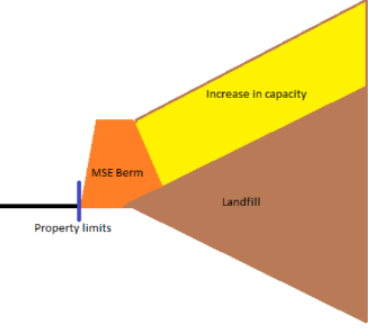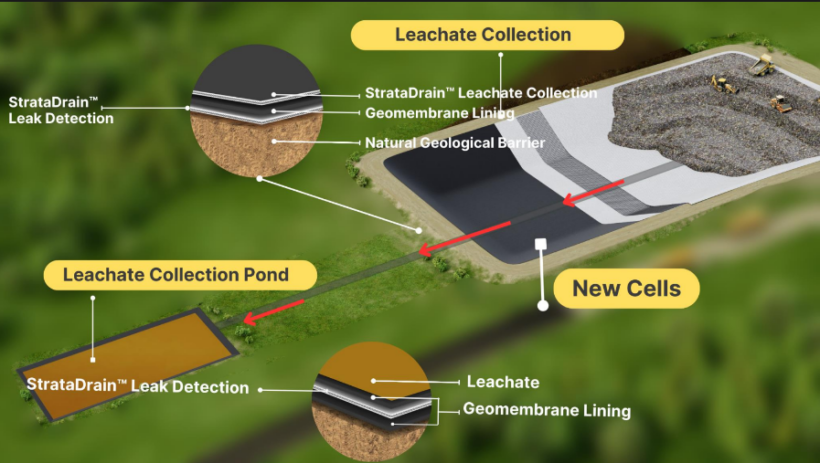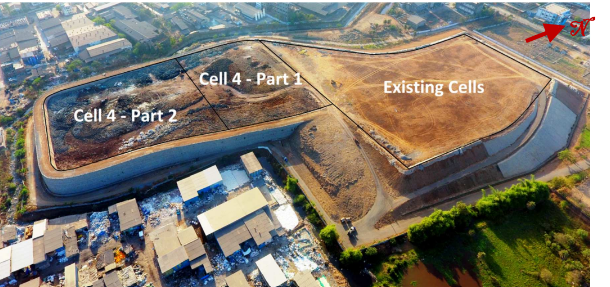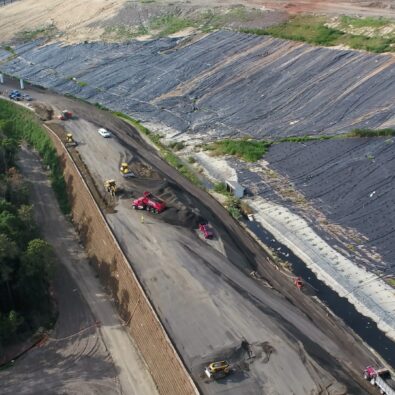Geosynthetics maximizing landfill airspace through vertical growth
The need for landfill expansion has increased due to growing populations, expanding city limits, and limited available space for waste disposal. Maximizing landfill capacity has become crucial to meet modern waste management challenges. To this end, landfill expansion can be classified into three methods: horizontal expansion, vertical expansion, and hybrid approaches. Each site requires specific treatment based on the age and type of waste, the landfill’s height, and its water content. In this blog, we focus on vertical landfill expansion and the ways in which we expand an available landfill space. Vertical landfill expansion deals with the idea of adding more height and claiming more airspace for expansion of the site.
What is vertical landfill expansion?
Vertical landfill expansion involves increasing the height of existing landfills to maximize capacity without needing additional land. Vertical expansion is especially useful in densely populated regions where acquiring new land is impractical or costly. By optimizing the use of existing landfill airspace—the volume of space on a landfill site permitted for the disposal of municipal solid waste (MSW)—vertical expansion helps to maximize the efficiency of waste management operations, prolong the operational lifespan of landfill sites, and reduce the need for new landfill development.

Vertical airspace management in landfills
The process is often facilitated by incorporating an MSE berm around the landfill site to optimize space utilization. Using MSE berms, steep structures with face angles of 70 degrees or more can be constructed, maximizing landfill capacity. This approach can contribute to overall project cost-effectiveness (e.g., by reducing land acquisition needs) and maximizes airspace utilization, though approval processes, while still significant, may differ from those for entirely new landfill sites.
Types of airspace management
While there are different types of airspace management techniques focused on creating more disposal capacity, within the purview of civil engineering for vertical expansion, we focus on methods like perimeter retaining walls or Mechanically Stabilized Earth (MSE) perimeter berms. In the case of MSE Perimeter Berms, we often employ this technique when lateral expansion is not possible for a given site. Traditional, unreinforced soil embankments require very flat side slopes (e.g., 1V:4H or approximately 14 degrees) to remain stable, which occupies a large land footprint. Strata’s steep slope solutions using StrataGrid allow these embankments to be constructed at much steeper angles, effectively and safely maximizing land use and airspace. Strata MSE berms have been used for vertically expanding an existing landfill, which may involve more streamlined approvals compared to establishing entirely new sites and can save on costs associated with land acquisition while providing extra storage capacity. Though there are other ways such as waste compaction, shredding and other methods –we will limit the purview of this blog to civil engineering focused techniques.
Role of geosynthetics in landfills
Geosynthetics play a vital role in ensuring the safety, stability, and efficiency of waste containment systems. These versatile products serve specialized functions that contribute significantly to landfill operations. With advancements in waste management technologies, geosynthetics are crucial for ensuring the environmental soundness and structural stability of landfills. Understanding the benefits of geosynthetics allows for enhanced landfill design and performance, contributing to environmental protection for current and future generations.

Key components and benefits
Geosynthetics include a range of products such as geotextiles, geomembranes, geogrids, geonets, and geocomposites. Each serves a specific function, from separation and filtration to reinforcement, drainage and gas collection.
Why geosynthetics are used in vertical landfills?
Vertical landfill expansions face challenges like settlement, which arise as waste accumulates over time. Geosynthetics play a crucial role in addressing these challenges and enhancing the overall performance of expanded landfills.
1. Stability enhancement: Geosynthetics (primarily geogrids for reinforcement, but also geotextiles for separation/filtration supporting stability) enhance stability in expanded landfills, ensuring structural integrity despite increased height.
2. Erosion control: Preventing erosion is critical in vertical expansions. Geosynthetics (e.g., geotextiles, erosion control blankets, turf reinforcement mats, geocells) protect the landfill cap and slopes from erosion caused by wind and water.
3. Containment efficiency: Geosynthetics (specifically geomembranes and geosynthetic clay liners – GCLs) enhance the containment efficiency of landfills, securely isolating waste materials and associated byproducts from the surrounding environment.
Design and application of vertical landfill expansion
Placing new waste over older, decomposing waste introduces new loads that can reactivate or accelerate settlement of the underlying material. This in turn leads to deformations in mineral and synthetic barriers if proper reinforcement structures are not in place. Therefore, design becomes a key element when accounting for expansion of an existing site.
Design principles
When using geosynthetics for vertical landfill expansion, there are a number of factors we must account for. Right from managing the existing volume, settlement of underlying waste, compaction of new waste, and space constraints, to ensuring the structural integrity of the new space is intact –there is a considerable amount of foresight and careful consideration of existing conditions needed to ensure the new space is finally safe, cost-effective and achieves the objectives of providing more waste management space. Further, slope failures are a common and typical concern for landfills. Space constraints and complex regulatory approval requirements further compound these challenges
Design considerations for vertical landfill expansion
Unlike the traditional earth embankment with a trapezoidal cross-section, the structure of reinforced soil structures is slim, occupying a land footprint only to the extent of its utility need, with very steep side-slopes. What’s more is that compared to a reinforced concrete or structural steel system, for similar earth retention applications, its cost is often significantly lower. This is a key consideration because space is at a premium and structural stability must be ensured efficiently. The design features for landfills incorporating geosynthetics include applications of reinforced soil technology and innovative concepts for greening steep embankment slopes, often involving textured geomembranes as part of the liner system or specialized cover systems like geocells placed over the geomembrane liner for surficial soil stability and vegetation support.
Case studies
1. Strata Geosystems built India’s first vertical landfill: A historic landmark

The Vapi Green Enviro Limited landfill cells ran out of space to take in the increasing waste being produced by industries in the area, posing a very pressing problem. Due to the availability of less space and cost concerns, horizontal expansion was not feasible. Strata Geosystems brought a revolutionary solution to the tableᅳvertical expansion of the landfillᅳchanging the game.
The design included a 14m high retaining wall with a steep 70° face, which was constructed using a reinforced soil solution. We utilized a reinforced soil structure with a precast concrete modular block fascia. This stable structure was designed to work in conjunction with the landfill’s overall barrier system—a composite lining typically made of a geomembrane and GCL—to maximize landfill capacity with the utmost regard to safety. The project involved vertical expansion over existing embankments, which first required strengthening with soil nails to provide a stable foundation for the new reinforced soil walls. Greening steep slopes of the landfill, which were lined with a geomembrane, was achieved by the use of StrataWeb geocells supported by StrataGrid geogrid for soil reinforcement and vegetation growth for the slope as steep as 1V:1.5H (approximately 33.7 degrees).
For the construction, engineered systems such as StrataSlope (for reinforced soil slopes) and StrataBlock (for modular block retaining walls) were implemented. The primary containment of landfill leachate is achieved by a dedicated impermeable liner system (e.g., geomembrane and/or GCL) within the landfill cell. The StrataGrid geogrid reinforces the soil mass to ensure the stability of these steep structures, including any internally wrapped-face soil bag constructions that might form part of the reinforced fill, but it does not itself prevent leachate leakage. Meanwhile, StrataBlock, precast concrete modular blocks, provided a solid outer facade, giving it a fortress kind of appearance for the structure. In spite of the difficulties, Strata’s team delivered a landmark solution that served not only the pressing needs of Vapi Green Enviro Limited but also set a notable standard for landfill design in India.
2. Vertical expansion of ACUA landfill with MSE Berm, NJ

In Egg Harbor Township, New Jersey, the Atlantic County Utilities Authority (ACUA) faced a pressing need to expand storage capacity at their solid waste landfill to accommodate waste for the next 20 years. Due to restrictions on lateral expansion caused by space limitations, costs, community objections, and environmental regulations, they required a vertical expansion. The existing containment berm lacked the stability to support additional height and could not be raised further without significant reinforcement or reconstruction. They expanded the landfill vertically by constructing an additional MSE berm, which significantly increased its height.
They entrusted Wyndham Construction, LLC, with this complex project, which constituted Phase II of the landfill’s vertical expansion. Strata’s solution played a pivotal role in the project, using StrataGrid master rolls, black steel welded wire forms and struts, and a combination face wrap (SB1120 geotextile and permanent TRM [Turf Reinforcement Mat]). We deployed StrataGrid, measuring 12.5 feet in width and significant lengths (e.g., often 150 to 300 feet, or potentially longer custom rolls for such large-scale operations), through a spooling operation, ensuring minimal waste and reduced time and costs.
The Strata MSE berm’s key advantage lies in its ability to enhance landfill capacity without expanding its footprint. StrataGrid wrap and wire form facing contribute to the structure’s flexibility, helping accommodate potential differential settlement of the underlying waste. The backfill material used for the reinforced zone was Reclaimed Asphaltic Pavement (RAP), which was confirmed as suitable after extensive third-party laboratory testing. This method of expansion not only proved cost-effective but also swift, aligning with the project’s aggressive construction schedule and the need for a well-planned execution. Overall, Strata’s innovative MSE solution provided a robust and efficient method for ACUA to meet their future waste storage needs, demonstrating significant advantages in both construction speed and cost management.
Key learnings & innovations of Strata Geosystems
Our landfill design projects integrate advanced technology, innovative problem-solving, and sustainable practices to maximize efficiency. The two projects show that the use of vertical expansion techniques to maximize the landfill capacity within a space-constrained area is quite feasible and successful. These projects have illustrated how dumping capacity can be increased by using reinforced soil structures and special engineering solutions, such as steepened slopes and specific reinforcement systems, subject to height and infrastructure limitations. We have engineered products like StrataGrid, StrataSlope, StrataWeb, StrataTex HSR and more for providing sustainable and durable landfill expansion solutions. Our advanced geosynthetic products contribute meaningfully to modern landfill technology, promoting efficient waste management and environmental preservation.
